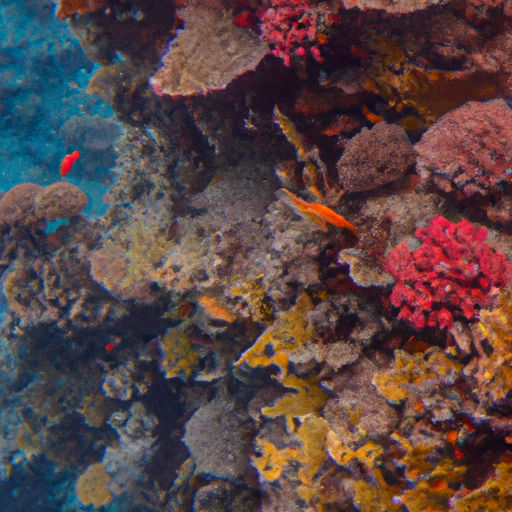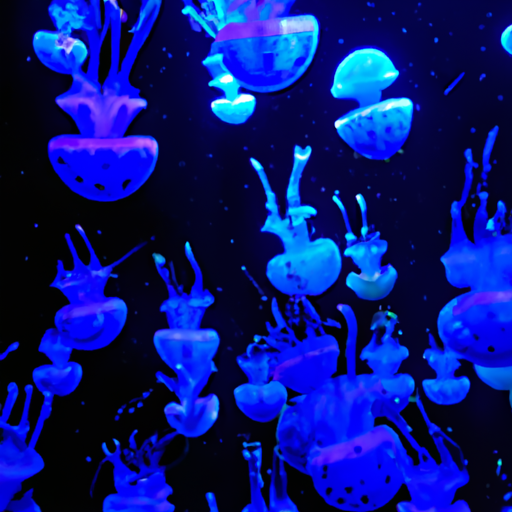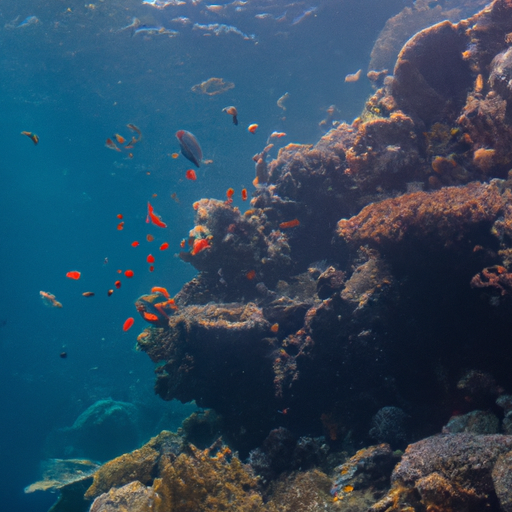
The Wonders of the Ocean: Unveiling the Marvelous Diversity of Marine Life
The ocean is a vast and mysterious realm filled with an astonishing array of marine life. Exploring the fascinating diversity of creatures that inhabit these underwater ecosystems is a captivating adventure that never fails to amaze and enlighten. From the tiniest microscopic organisms to the gigantic whales, the ocean is a treasure trove of unique and extraordinary species.
One of the most remarkable aspects of marine life is its incredible diversity. The ocean is teeming with millions of different species, each with its own distinct characteristics and adaptations. From brightly colored fish darting between coral reefs to the graceful movements of sea turtles gliding through the water, the range of marine life is awe-inspiring.
One of the reasons for this diverse array of species is the incredible variety of habitats available in the ocean. From shallow coastal areas to deep-sea trenches, each habitat provides a unique set of conditions that different organisms have evolved to thrive in. For example, coral reefs are home to a complex web of marine life, with countless species relying on the coral for food, shelter, and protection. In contrast, the open ocean is inhabited by creatures adapted to survive in the vast expanse of water, such as whales and dolphins.
The immense biodiversity of marine life extends not only to vertebrates but also to invertebrates and plant life. For instance, coral reefs support an astonishing amount of invertebrate species, including sponges, crustaceans, and mollusks, each playing a vital role in the reef ecosystem. Seagrass meadows, another important marine habitat, are home to a diverse range of plant species, providing shelter and food for various organisms such as seahorses and turtles.
Unveiling the marvelous diversity of marine life requires a combination of scientific research, exploration, and conservation efforts. Scientists and marine biologists study these unique species to understand their ecological role, behavior, and potential applications in various fields, including medicine and biotechnology. Exploration expeditions equip us with the knowledge to appreciate and preserve these delicate ecosystems, ensuring their survival for future generations.
There is still so much to uncover and learn about the wonders of the ocean and its incredible diversity of marine life. As we continue to explore and protect these fragile ecosystems, we gain a deeper appreciation for the interconnectedness of all living beings and the importance of preserving our precious oceans for generations to come.
From Vibrant Coral Reefs to Mysterious Deep-Sea Creatures: A Journey into the Many Faces of Marine Life
Exploring the fascinating diversity of marine life is an awe-inspiring journey that takes us from the vibrant coral reefs to the mysterious creatures thriving in the deep-sea. The oceans of our planet are home to an array of species that are as intriguing as they are diverse.
One of the most remarkable aspects of marine life is its incredible variety. From tiny plankton to enormous whales, the oceans host an astonishing range of organisms. Coral reefs, for example, are renowned for their vibrant colors and teeming biodiversity. These underwater ecosystems are bustling with life, housing thousands of species including corals, fish, sharks, and turtles. Each organism has its own unique role to play in maintaining the delicate balance of the reef.
As we venture deeper into the ocean, we encounter a whole new world of creatures that have adapted to survive in the extreme conditions of the deep-sea. These depths remain largely unexplored, making them all the more mysterious. Bioluminescent jellyfish, anglerfish with their luminescent lures, and elusive giant squids are just a few examples of the strange and wonderful species that dwell in this dark and unforgiving environment.
Aside from their sheer diversity, marine organisms also showcase remarkable adaptations that enable them to thrive in their respective habitats. For instance, certain types of fish have developed the ability to camouflage themselves, blending seamlessly with their surroundings to avoid predators. Others have evolved protective spines or venomous defense mechanisms to ward off potential threats.
Understanding and preserving the diversity of marine life is of utmost importance. The oceans not only provide a habitat for countless species but also play a crucial role in regulating the Earth’s climate and maintaining oxygen levels. Additionally, many marine organisms have contributed to scientific advancements, offering insights into areas such as medicine and biotechnology.
Exploring the fascinating diversity of marine life is an ongoing endeavor. Through research, conservation efforts, and responsible tourism, we can continue to unravel the mysteries of the ocean and ensure the preservation of this invaluable ecosystem. By appreciating the many faces of marine life, we gain a deeper understanding of our interconnectedness with the natural world and the need to protect it for future generations.
Exploring the Extravagant Biodiversity of the Seas: Astonishing Species and Ecosystems
Exploring the fascinating diversity of marine life is an awe-inspiring journey that takes us into the depths of the world’s oceans. The seas are home to a vast array of species and ecosystems, each more astonishing than the last. From the tiniest microscopic organisms to the majestic giants of the ocean, marine life offers a captivating glimpse into the wonders of biodiversity.
One of the most remarkable aspects of marine life is the incredible number of species that call the oceans their home. It is estimated that over one million species live in the seas, with countless others waiting to be discovered. From colorful coral reefs teeming with tropical fish to the mysterious creatures of the deep sea, each habitat offers its unique set of organisms adapted to its specific conditions.
The biodiversity of marine life is not only fascinating but also crucial for the health of our planet. Marine ecosystems provide numerous ecosystem services, such as oxygen production, nutrient cycling, and climate regulation. They also support the livelihoods of millions of people who depend on the oceans for food and income.
Exploring the diversity of marine life is a continuous endeavor, with new species being discovered regularly. For example, scientists recently discovered a new species of octopus in the waters off the coast of Hawaii. This particular octopus has unique characteristics, such as webbed tentacles that allow it to glide through the water with ease.
Furthermore, marine life is not limited to just fish and other sea creatures. It also includes fascinating plants such as seagrasses and phytoplankton that play a vital role in the marine food chain. These plants not only provide food and habitat for marine organisms but also contribute to the overall health of the oceans.
Protecting the diversity of marine life is crucial for maintaining the delicate balance of our planet’s ecosystems. Human activities, such as overfishing, pollution, and habitat destruction, pose significant threats to marine biodiversity. By understanding and appreciating the fascinating diversity of marine life, we can work towards preserving and conserving these fragile ecosystems for future generations to enjoy.
In conclusion, exploring the fascinating diversity of marine life offers us a glimpse into the astonishing biodiversity that exists in the world’s oceans. From the smallest organisms to the largest creatures, each species contributes to the intricate tapestry of marine ecosystems. By continuing to explore and protect these diverse environments, we can ensure the survival of marine life for generations to come.
Protecting Our Underwater Treasures: Conservation Efforts for Preserving Marine Life
The underwater world is teeming with an incredibly diverse array of marine life, making it a fascinating and awe-inspiring place to explore. From vibrant coral reefs to mysterious deep-sea trenches, there is a wealth of beauty and complexity waiting to be discovered beneath the waves.
One of the most important aspects of marine conservation is understanding the incredible diversity of marine life and the vital roles each species plays in maintaining the health of our oceans. Scientists estimate that there are over one million different species living in our oceans, and yet, we have only scratched the surface in terms of our knowledge and understanding of these creatures.
Exploring the vast array of marine life is not only a matter of intrigue and curiosity, but it also has significant implications for conservation efforts. By studying different species and their interactions within their ecosystems, scientists can better identify vulnerable populations and implement targeted conservation strategies.
One example of the mind-boggling diversity of marine life can be found on coral reefs. These vibrant and delicate ecosystems are home to an astounding number of species, with some reefs housing more species than an entire rainforest. From colorful fish to intricate invertebrates, the variety of life forms found on a single reef is truly astounding.
However, coral reefs are not the only place to witness the incredible diversity of marine life. The deep sea, which constitutes the majority of our oceans, is home to a vast number of unique and often bizarre creatures. From bioluminescent jellyfish to giant squid, the deep sea is a treasure trove of enigmatic and otherworldly species.
Exploring and documenting the diversity of marine life is a colossal task that requires collaboration and dedication from scientists, conservationists, and the general public. Together, we can continue to unravel the mysteries of the underwater world and ensure the preservation of its remarkable inhabitants for generations to come.


